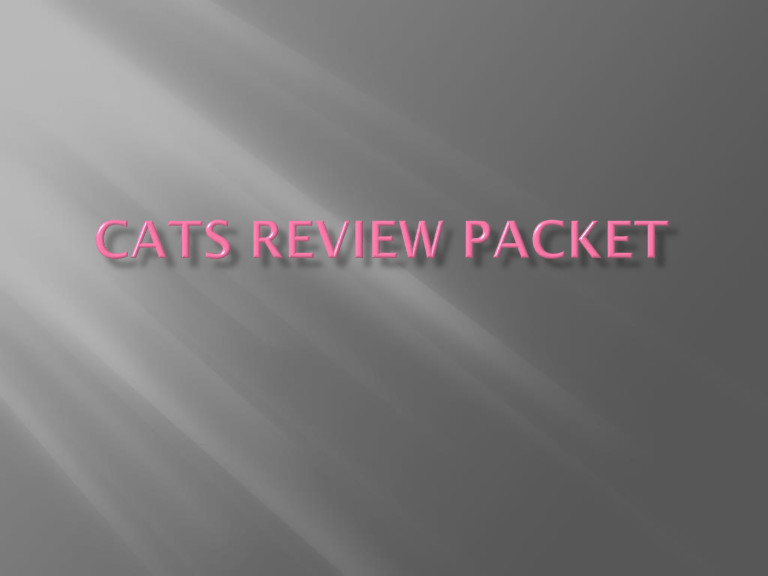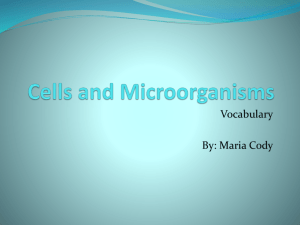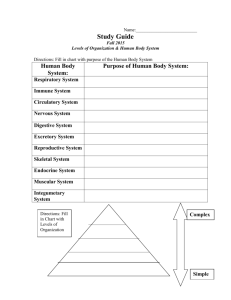Document

All the non-living things in an ecosystem.
Trees
Raccoon
Grass
Tulip
Deer
Squirrel
The continuous movement of water from the surface of the earth to the atmosphere
(troposphere).
The continuous movement of carbon dioxide and oxygen between living things and the environment.
The constant movement of nitrogen between living things and the environment.
A biome is a large region characterized as having a distinct climate and specific types of plants and animal life.
Grassland Biome are areas in which the main plants are grasses. Summers are 86 F,
Winters 32F, can support many species of animals: hawks, prairie dogs, bison, wheat and grasses.
Taiga Biome: South of the tundra. Much of Canada,
Alaska, and North of the
Rocky Mountains of the US.
Tropical Rain forest is near the equator, warm temperatures (77F), abundant rainfall, many unique species of animals.
A food chain traces the path of energy as it moves from one organism to the next. Energy begins with the sun.
Food Webs are the interaction of many food chains within an ecosystem.
The special role an organism plays within its habitat.
The largest population that an area can support.
Animals with backbones
Through Gills
Reptiles are cold-blooded
Symbiosis: Relationship between two organisms.
Mutualism, Commensalism, and Parasitism
Something that helps an organism get food, build a home, or protect itself.
EX: if a human cuts down the habitat of raccoons, they will adapt and learn to live in the new environment. Instead of hunting their food in the woods, they will search in other places, such as, garbage cans.
Plant cells have cell walls and chloroplast.
Animals cells do not have either.
Both have cell memebranes.
Cell Tissue Organ Organ
System Organism
Orgamism Organ
Systems Organs Tissues Cells
Multi-cellular Uni-cellular
Osmosis: Diffusion of water across the memebrane (High to
Low Concentration)
Diffusion: Movement of a molecule from an area of high concentration to an area of low concentration.
Photosynthesis: Process that allows plants to make its own food. Takes in CO2 and gives off O2.
Respiration: O2 combines with glucose and CO2 and water is given off.
Gregor Mendell
The passing of traits from parents to offspring
Homozygous/Pure: Same allele for a given trait.
Example: TT; tt
Meiosis: Sexual Reproduction. ½ the genetic material in cell division is passed to offspring. Only in sex cells: sperm and egg.
Mitosis: Asexual Reproduction Cell division. Where 100% of genetic material gets passed on from one parent cell.
XX
Density, Ductility, Malleability,
Boiling Point, Melting Point,
Electrical Conductivity.
Identifies an element or compound.
Properties that do not change for the element or compound
Describe matter based on its ability to change into a new substance without different properties.
Flammability is a chemical property
Rusting
Atoms
Matter can not be created or destroyed
Acid is any compound that produces H+ in water.
Examples: Coffee, Tomatoes,
Vinegar, Lemons, Stomach
Acid.
PH scale 0-6.9
Base is any compound that produces OH- in water.
Examples: Milk, Blood,
Ocean Water, Antacid, Soap,
Ammonia, Bleach.
PH 7.1-14
PH of 7.
Neither acidic or basic
Mixture: a combination of two or more substances that have not combined chemically. They can be separated by physical means.
Compound: Matter made of two or more elements. The elements are chemically bonded; can not be separated by physical means.
Force that resists the motion of two surfaces that are touching each other.
Force of attraction between any two objects.
Combination of all the forces acting on an object.
Mass: amount of matter in an object measured in grams.
Weight: A measure of the force of gravity on an object.
Power: How much work a machine can do in a unit of time.
Fulcrum is in the center.
Example: Door hinge, pop bottle opener
Lever: a long rigid bar that rests on and pivots around a support called a fulcrum
100 C
From Hot to Cold
Conduction: Direct Heat
Convection: Heat transfer through air or liquid
Radiation: Heat transfer through space
Regularly replaced or replenished by nature. Wind is a renewable energy source.
Sun is the source of all energy and is the primary source of all energy.
Closed
Insulator: a material that slows the movement of energy from one place to another. Ex. Thermos bottle.
Conductor: materials that let electrical charges flow through them. Ex. Metals, copper, aluminum wire.
Plant tissue that transports water.
Flowering plants – plants that produce flowers. Example: trees, shrubs, garden plants.
Temperate climate: moderate temperature and moderate precipitation.
Weather: conditions in the atmosphere including humidity, cloud cover, temperature, wind, and precipitation.
Climate: the general pattern of weather in a particular part of the world over a long period of time.
troposphere
Location on the Globe and how far you are from the equator.
Two factors that determine climate: temperature and precipitation.
The tilt of the Earth’s axis
Igneous
Metamorphic
Sedimentary
Sedimentary
Energy that travels through matter as mechanical waves and can be heard by ear.
Produced by sound vibrations.
Light waves travel faster than sound waves.
You see lightening before you hear the thunder.
One independent variable for a valid experiment.
Control is what stays the same in the experiment.
You should only have 1 control in an experiment.






